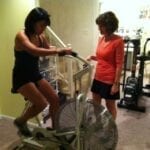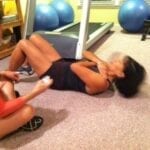Written by Jody Miller, M.A., RCEP
October 23, 2013
For quite some time I have been asking Dr. Tran to come see what I do first hand. She finally took me up on my offer! With Dr. Seidelman as witness and photographer, Dr. Tran underwent a Clinical Fitness Assessment.
A comprehensive Clinical Fitness Assessment is designed to provide critical information for developing effective personalized exercise and nutrition programs. The results are used to troubleshoot what has not been working and/or identify weak systems in the body, define attainable goals, and monitor and track progress so that further modifications can be made as needed.
There are 5 key areas that are assessed: body composition, muscular strength/endurance, joint range of motion/muscular flexibility, cardiovascular health (aerobic capacity), and energy balance/nutritional health.
Over the coming months, I hope to provide you with helpful information related to each of these key areas. The first topic for discussion is joint range of motion-muscular flexibility!
It’s amazing, just as Dr. Tran experienced for herself, that someone who is extremely fit can have an unrecognized weakness that deserves attention! While her other 4 key areas of fitness tested “excellent”, flexibility was “poor” for both her upper body and lower body.
This is not unusual. Why do many people have tight musculature and joints? First, generally the stronger we are the tighter our muscles and tendons tend to be… especially if we are predominantly performing strengthening exercises, without stretching regularly. Second, “aging”. This seems to hold especially true for women as we go through peri-menopause and menopause. The hormone estrogen plays a remarkable role in helping to keep our connective tissue supple. As estrogen levels decline in our bodies, that connective tissue becomes tight and “knotted”.
The good news is that we CAN improve our joint range of motion and muscular flexibility no matter what our age! I like to recommend that all exercise programs give equal attention to the three components of fitness – strength, cardio, and flexibility! This means if you spend 30 minutes engaged in cardiovascular activities (i.e. walking, biking, swimming etc…), then you would want to spend the equivalent 30 minutes engaged in stretching activities and another 30 minutes performing strengthening activities!
I know you are now saying, “what is she crazy, I barely have 30 minutes total!” So I am definitely NOT saying you need 90 minutes of exercise, but rather split the time you DO have evenly! In my experience, women tend to spend most of their exercise time focusing on cardio, a little time on stretching and barely any time on strength. Men on the contrary tend to spend most of their time with muscular strengthening, a little time on cardio and no time on stretching.
The Flexibility Prescription: focus on your “tight” areas. Develop a repertoire of stretches that can pinpoint those muscles. Perform them consistently. I generally recommend 5-10 positions performed daily, holding each position for 20-30 seconds, then repeating 1-3 times as necessary. Bands, straps, balls and foam rollers are wonderful tools to help facilitate stretching. This is a great way to minimize long term stress on the joints, promote good posture, prevent falls, and dissipate painful muscular tension!


